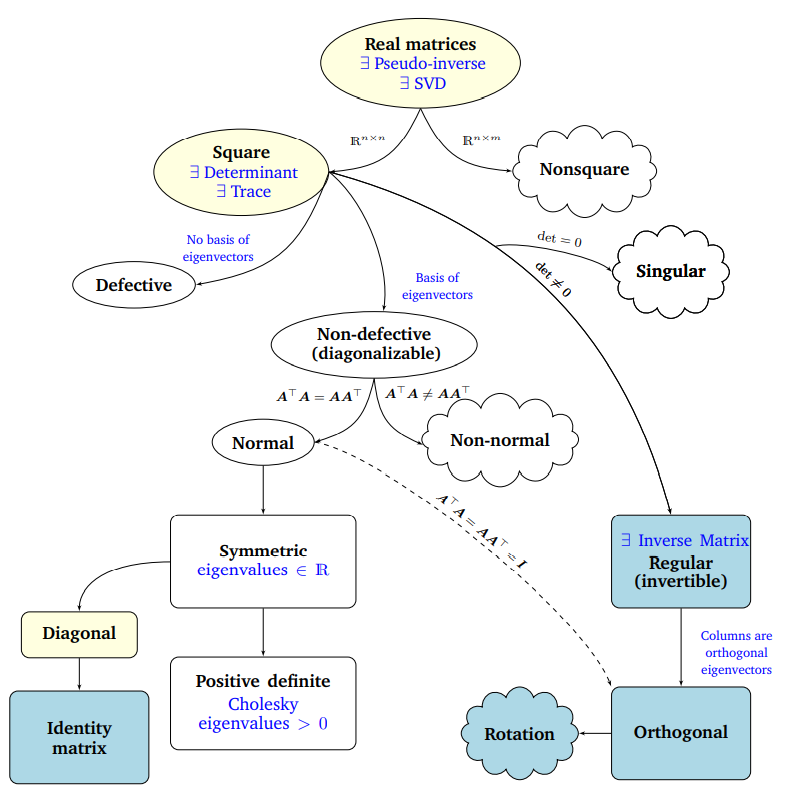Matrix Phylogeny
2장과 3장에서는 linear algebra와 analytic geometry에 대해 살펴봤습니다. 그리고 4장에서는 matrix와 linear mapping의 기본적인 특성에 대해 살펴봤습니다.

위 그림은 다양한 타입의 행렬과 이 행렬들에서 수행할 수 있는 연산들(파란색 글씨) 간의 관계를 트리로 보여줍니다. 검정색 화살표는 “is a subset of”를 의미합니다.
일단 우리는 모든 실수 행렬(real matrices) $\boldsymbol{A}\in\mathbb{R}^{n\times m}$ 대해 고려합니다.
Non-spuare matrices (where $n\neq m$) 에서 SVD는 항상 존재하며, 이는 4장에서 살펴봤습니다.
Square matrices $\boldsymbol{A}\in\mathbb{R}^{n\times n}$ 에서 determinant 는 역행렬(inverse matrix)의 존재 여부를 알려줍니다. 즉, 행렬 $\boldsymbol{A}$ 가 regular, invertible matrices 에 속하는지 판단합니다. 만약 $n\times n$ 행렬이 n개의 linearly independent eigenvectors를 가지고 있다면, 이 행렬은 non-defective 이고 eigendecomposition (Theorem 4.12) 이 존재합니다. 그리고, repeated eigenvalues가 있다면 그 행렬은 defective matrics 이고 대각화가 불가능합니다.
Non-singular 행렬과 non-defective 행렬은 같지 않습니다. 예를 들어, rotation matrix는 invertible (determinant is nonzero) 하지만 대각화(in the real numbers)는 불가능할 수 있습니다 (eigenvalue가 실수라는 것을 보장하지 못함).
Non-defective인 square $n\times n$ 행렬로 더 들어가서, $\boldsymbol{A}^\top\boldsymbol{A} = \boldsymbol{AA}^\top$ 을 만족할 때, $\boldsymbol{A}$ 는 normal 하다라고 합니다. 만약 $\boldsymbol{A}^\top\boldsymbol{A} = \boldsymbol{AA}^\top = \boldsymbol{I}$ 를 만족하면, $\boldsymbol{A}$ 는 orthogonal (Definition 3.8 참조)하다고 합니다. Orthogonal matrices 집합은 regular (invertible) matrices의 subset이며, $\boldsymbol{A}^\top = \boldsymbol{A}^{-1}$ 을 만족합니다.
Normal 행렬에 속하는 행렬 중에는 $\boldsymbol{S} = \boldsymbol{S}^\top$ 을 만족하는 대칭행렬(symmetric matrices) $\boldsymbol{S}\in\mathbb{R}^{n\times n}$ 이 있습니다. 대칭행렬에는 오직 실수인 eigenvalues만 있습니다. 대칭행렬의 부분집합은 모든 $\boldsymbol{x}\in\mathbb{R}^n\backslash\lbrace\boldsymbol{0}\rbrace$ 에 대해 $\boldsymbol{x}^\top\boldsymbol{Px} > 0$ 를 만족하는 positive definit matrices $\boldsymbol{P}$ 로 구성됩니다. 이러한 경우, Cholesky decomposition (Theorem 4.18)이 존재합니다. Positive definite matrices는 오직 positive eigenvalues만을 가지며, 항상 invertible 합니다(nonzero determinant).
대칭행렬의 다른 부분집합은 대각행렬(Diagonal matrices) $\boldsymbol{D}$ 로 구성됩니다. 대각행렬은 곱셈과 덧셈에 닫혀있지만, 항상 group(군)을 형성하는 것은 아니며, 오직 모든 대각 성분이 nonzero일 때만 군을 형성합니다. 특별한 대각행렬로는 단위행렬(identity matrix) $\boldsymbol{I}$ 가 있습니다.